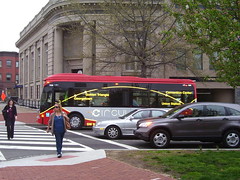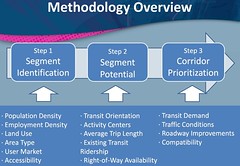Methodology for determining transit expansion, Orlando (Lynx system)
I was at a holiday party and someone who claims he doesn't read my blog asked me why I didn't blog an entry against the expansion of the DC Circulator bus system into Anacostia/East of the River.
I told him it was a combination of (1) my giving up, because my arguments about the need for standards and metrics justifying this level of service have had no effect on expansion planning for Circulator bus service in DC, and (2) that it is possible, that like the service in Adams-Morgan/Columbia Heights, it's possible that the service is justified.
Now I have blogged a number of entries about the Circulator and neighborhood expansion. The Circulator bus service is designed to be high frequency. High frequency services are only justified when there is high ridership.
This concept is captured by a slide in the 2030 Transit (Lynx) Plan for the Orlando Metropolitan Area in Florida.
The slide lays out the three step process for determining areas where service should be provided, and where expansion is justified by travel demand. (Other slides discuss different types of transit services, the choice of which are based on capacity, speed, distance, and ridership projections.)
This is the kind of process we don't seem to have in DC, for DC-specific expenditures on transit service development and expansion. Instead, it's political, spreading around service to various wards (which is what happened with the Main Street program in its later years as well) to satisfy Councilmembers and their constituents, rather than being justified by demand and a consideration of the best use of scarce financial resources.
The Circulator bus lines serving Downtown and Georgetown have the type of higher ridership that justifies Circulator-type service.
For neighborhood services, the Columbia Heights-Adams Morgan route has closer to the kind of ridership necessary to justify high frequency, while the Capitol Hill-Navy Yard Circulator does not.

The Union Station-Navy Yard DC Circulator uses 30 foot buses, because ridership projections did not justify larger buses.
In my typology of metropolitan transit networks, there is a category for intra-neighborhood transit service (called the center city tertiary transit network), and this level of service justifies subway station and commercial district centric bus service. But that means that a Circulator in this area ought not to then go to McPherson Square, instead it should move people around the neighborhoods, the transit stations, and the commercial districts.
It could be that East of the River bus services need to be reconfigured to better serve activity centers and subway stations. That was suggested in a comment on a blog entry on this topic last January.
Labels: transit, transportation planning




0 Comments:
Post a Comment
<< Home